
Current filter:

The Hawke’s Bay Regional Council is focused on restoring biodiversity which is in crisis across the region.
Climate change, invasive species, pollution and changing land use has contributed to the loss of 77% of the original indigenous forest that once covered the region. In New Zealand, 4000 species are currently threatened or at risk of extinction.
Regional Councillor and Environment and Catchments Committee Chair Hinewai Ormsby says biodiversity is a taonga, and we need to protect it for the community’s wellbeing.
“Biodiversity is a technical term, but it can be everything from the birds you see in your backyard to the whales that travel out in Hawke’s Bay, to native trees. It’s what connects and sustains us as a community, and is of fundamental importance,” says Councillor Ormsby
“At the Regional Council, climate-resilient biodiversity is one of our four strategic pillars. We are focused on restoring our indigenous habitats and ecosystems and are doing fantastic mahi to address biodiversity loss – but we need to do more working together as a region.”
Regional Council Group Manager of Integrated Catchment Management Iain Maxwell says the Regional Council is working to restore biodiversity on a number of fronts.
“We’re protecting and restoring indigenous bush remnants in Hawke’s Bay – through what is called our ecosystem prioritisation programme. In these areas, we are establishing deer fencing, pest plant and animal control and planting. The success of this programme has hinged on working with our landowners and integrating other programmes and funding from a large number of external agencies and stakeholders, such as Department of Conservation, Ministry for the Environment, QEII Trust, the rural sector and land occupiers.”
“We are also planting trees and conducting erosion control work on erosion-prone land, through our Erosion Control Scheme. Through this work we are curbing erosion, improving water quality, and terrestrial and aquatic biodiversity through habitat protection.”
‘We are also in the early stages of delivering a $2 million Jobs for Nature project that will deliver 42 km of deer fencing alongside pest plant and animal control at 14 sites protecting 423ha of acutely threatened native bush’.
“While these projects and our other work are protecting pockets of land and critically endangered areas of native bush, we need to do more to support biodiversity across the board,” he says.
The Regional Council is working on a strategy to better coordinate operational biodiversity projects and is looking at region-wide monitoring to assess the impacts of programmes.
The National Policy Statement for Indigenous Biodiversity will require the Regional Council to identify taonga species and support restoration of significant natural areas.
Find out more about our biodiversity work on our website.
12 November 2021
Disclaimers and Copyright
While every endeavour has been taken by the Hawke's Bay Regional Council to ensure that the information on this website is
accurate and up to date, Hawke's Bay Regional Council shall not be liable for any loss suffered through the use, directly or indirectly, of information on this website. Information contained has been assembled in good faith.
Some of the information available in this site is from the New Zealand Public domain and supplied by relevant
government agencies. Hawke's Bay Regional Council cannot accept any liability for its accuracy or content.
Portions of the information and material on this site, including data, pages, documents, online
graphics and images are protected by copyright, unless specifically notified to the contrary. Externally sourced
information or material is copyright to the respective provider.
© Hawke's Bay Regional Council - www.hbrc.govt.nz / +64 6 835 9200 / info@hbrc.govt.nz